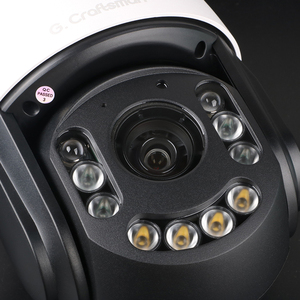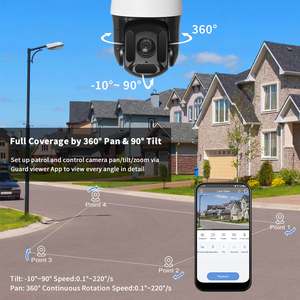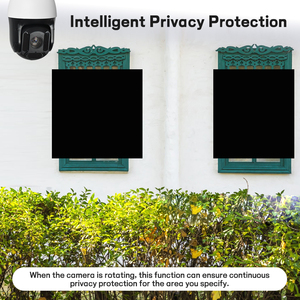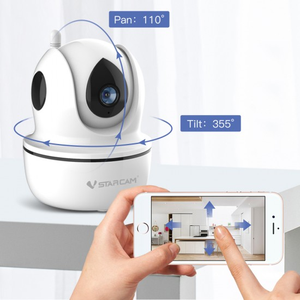(10000 products available)






































































































































































































































































Traditional PTZ Cameras
The most conventional and influential zoom, pan, and tilt (PTZ) camera is operated by a mechanical system that physically moves to capture images at different angles. Such cameras have servos that tilt and rotate to give them excellent flexibility in the areas they cover. Translational cameras can be set up to automatically carry out motion-tracking functions while providing manual controls for real-time PTZ functions. This traditional variation operates on a mechanical basis, although lifespan or wear and tear may decrease rotational functions.
Hybrid PTZ Cameras
The provision of both optical and digital zoom features to achieve enhanced flexibility in surveillance requirements characterizes hybrid PTZ cameras. Large-area observations can be completed by using the optical zoom function to focus on minute details in a given area by switching to digital zoom. Hybrid models are ideal where adaptability is required since such features make them versatile for diverse application settings.
Wireless PTZ Cameras
Cable installation limitations characterize such cameras, especially when there are limitations on power supply or when the installation area is hard to reach. To give flexibility in positioning, a wireless PTZ motion camera uses Wi-Fi or other wireless networks for video and audio transmission. A corded version might be more reliable in connections; however, the ease of use, installation, and many applications in different areas makes them popular.
Solar-Powered PTZ Cameras
A self-sustaining method of operating cameras achieves this through the use of renewable energy. With the addition of the solar panel, the PTZ IP camera can run indefinitely at an outdoor site even without mains electricity. This not only helps with its sustainability but also cuts the costs on electricity bills. That makes it so appealing for long-term use at remote sites.
Thermal PTZ Cameras
PTZ cameras use non-visual imaging systems to track movement based on heat given off by diverse objects, including human bodies. These cameras are particularly valuable in conditional monitoring that is low visibility, for instance, in total darkness or when there are smoke or fog conditions. Motion sensors are useful in security-sensitive sectors because they operate automatically, overcoming many conventional vision surveillance weaknesses.
360-Degree Rotation
A PTZ camera, as previously stated, will perform rotational, tilting, and zooming operations, thus allowing it to cover every angle within a given room. Such comprehensive movement capabilities make it possible to track any specific area of interest within its surroundings effectively.
Motion Tracking
With the advanced technology of PTZ cameras, tracking anything that is moving comes quite easily since they have embedded algorithms that detect and follow movement. When configured, the camera will automatically follow a person or object depending on the preset conditions, eliminating the need for manual operation and making surveillance an auto affair.
Zoom Capability
Zoom provides the clarity of the image; thus, a PTZ IP camera incorporates both optical and digital zoom features to enhance and minimize a field of view. While optical zoom will focus on the image without blurring because of lens manipulation, the digital one will simply crop the image in the process of showing you a larger view. Zoom is useful in identification applications, as it allows a clearer look at any features within the range of observation.
Night Vision
Many of the PTZ security cameras come with different technologies to ensure efficiency in night vision, from infrared to thermal. This function is highly vital for round-the-clock surveillance, as it will allow the camera to capture clear images in low-light conditions. The technology used will also ensure that the elements monitored will be visible even in total darkness or dim light.
Smart Alerts
Smart alerts are created to make the work of a surveillant easier by notifying an event or detection of an event that may have importance. Most PTZ cameras have built-in sensors, such as for motion and sound, that lead to alert generation in case of detected anomalies. This feature is present in mobile applications to allow the user to get live feeds and notifications on their smartphones within a short time of an occurrence.
Remote Access
Most PTZ IP cameras offer direct access through any given mobile or PC application, allowing users to view live footage, send commands to the camera, and check historical recordings from almost anywhere. This access feature is vital for many types of surveillance since instant monitoring can be achieved, for example, in critical places where prompt responses are required.
Cloud Storage
PTZ cameras are endowed with the capability of uploading footage to the cloud, which serves as additional storage for recorded video. This eliminates the possibilty of video loss due to overwriting, as it ensures that videos are secure and easily retrievable. It also offers flexible storage solutions, as users can opt for plans based on the amount of video data intended for storage.
Playback Functionality
Another important feature that comes in handy with surveillance systems is that recorded footage can also be played back; PTZ cameras do this with ease. Users can fast forward to important events, rewind to capture incidents, or pause for step-by-step analysis. Playback is vital for investigations of security breaches and for reviewing areas of interest.
Indoor and Outdoor Use
PTZ cameras come in different designs as to whether they should be used indoors only, or cleared for outdoor use, and those that can be used in both environments. Cameras designed for the outdoor environment possess weather resistance features, while those intended for indoor use do not necessarily have such capabilities. Most ip cameras ptz are versatile and hence can be installed and effectively used in diverse environments, both indoors and outdoors.
Integration with Security Systems
PTZ cameras are integrated into various security systems to enhance their effectiveness. For instance, cameras can be activated when an alarm system is triggered, prompting a PTZ camera to zoom in and track an intruder. Such integration creates an overall automated response to security breaches, increasing efficiency in monitoring and responding to incidents.
PTZ IP cameras are very helpful for monitoring security and creating a real-time picture at many places, including indoors and outside. With their extra features such as motion tracking, remote access, and zooming, these cameras may be used in a wide array of situations to enhance surveillance capabilities. The following situations highlight how useful these cameras are in securing property and people.
Border Security
With thermal imaging capabilities, PTZ cameras can track suspicious activities across borders in remote areas by following an intruder from heat signatures and often increasing night vision capabilities. They work with other sensors for a complete picture, thus allowing prompt responses to any invasion or irregularity with minimal risk to the guards.
Perimeter Security
The perimeter of a facility is among the most important areas to secure, and PTZ cameras are very effective in providing that coverage. Operating autonomously by tracking moving objects and zooming in on them, these cameras give real-time perimeter breach alerts. Facilities with vast and expansive grounds, like airports and military bases, need active surveillance for those areas.
Crowd Monitoring
Large public events such as concerts and festivals require effective crowd management; PTZ cameras make it possible. With live crowd movement monitoring, any unusual behavior is quickly detected and followed. Event organizers and public safety officials can prevent possible threats, manage emergency situations, and respond in real time to ensure safety.
Investigating Crime
Crime scene investigations need the best evidence possible for prosecution, and PTZ cameras are helpful in this area. Live or recorded footage may give investigators lead way into an investigation by following a suspect as he or she moves within a designated space. Their zoom capabilities also allow close examination of specific areas within the scene, enhancing crime scene evaluation.
Access Control
At sensitive facilities like data centers, access control is critical, and PTZ cameras add another layer of security. They follow individuals as they approach entry points, ensuring all suspicious activity is tracked in real-time. When combined with other access control measures, these cameras ensure only authorized personnel enter restricted areas while alerting security to any potential threats.
Event Detection
PTZ cameras are designed to capture movement within an environment, so detecting unusual activities is easy. This feature is very useful in places where constant monitoring is necessary, such as in banks or retail stores, to prompt instant alerts when suspicious behavior occurs. Proactive detection provides businesses with time-saving intervention opportunities to prevent theft or vandalism.
Coverage Area
Coverage area is an important factor that must be considered when selecting a PTZ camera for indoor and outdoor purposes. Areas that are large and need to be monitored require a camera with extensive zoom and motion tracking capabilities that are great for effective capturing. If monitoring is done in a confined space, a camera with a wide field of vision will work just fine.
Image Quality
The basic element determining the quality of images and, thus, surveillance is resolution. A 1080p resolution camera will provide clear and detailed images; a 4K camera will offer even more clarity, though at a greater cost. Also, other factors that contribute to image quality include night vision, which allows viewing in low-light conditions, and zoom capabilities to enable the viewing of distant objects or areas.
Speed and Accuracy
Another important aspect of speed in motion tracking is that the PTZ camera has to be fast in responding to motion with quick panning or tilting to catch the action. Accuracy is essential to follow moving objects effectively without drifting or losing focus. For applications where precise tracking is crucial, it can be important to consider technologies that enhance object-tracking performance, such as auto-tracking algorithms.
Installation Requirements
Installation also plays a part in selecting a PTZ camera. Wireless models are flexible in their installation since they will not need Ethernet cabling; they could be placed at strategic locations to get good signals. However, if it was wired, then there would be a need to consider the positions of the cable and whether it needed indoor or outdoor exposure. While options like PoE cameras ensure powered and in-service devices without extra power outlets, one must understand such features regarding installation convenience.
Integration with Existing Systems
A key factor in selecting a PTZ IPCamera is whether the device can work together with other present security systems. Cameras with ONVIF compatibility to ensure smooth integration with other surveillance equipment and software are suitable. It is also important to check if there are third-party applications for remote monitoring or controlling the camera.
Budget Considerations
In PTZ cameras, prices vary greatly on features and specifications. The most basic features like motion tracking, zoom, and remote access may be more affordable if not professional-cum-industrial-grade. These great features to have when on a budget can serve well for home use or small businesses. However, investing high end into a camera that holds all these features will pay off at commercial places where optimum security is necessary towards great performance, reliability, and image quality.
A1: An automotion-tracking PTZ IP camera is an advanced surveillance device that automatically detects, follows, and captures moving subjects within its field of view using intelligent tracking algorithms.
A2: The benefits of PTZ IP cameras include proactive surveillance, automated tracking, comprehensive coverage, efficient monitoring, and enhanced security through real-time alerts and detailed recording capabilities, all contributing to more effective and reliable security outcomes.
A3: Yes, many PTZ cameras are designed with weatherproof enclosures, making them suitable for outdoor surveillance in various environmental conditions.
A4: Many PTZ IP cameras are compatible with existing security systems, especially those adhering to open standards like ONVIF, allowing for seamless integration with other surveillance devices and software.
A5: Motion tracking uses advanced algorithms to detect and follow moving objects, enabling the camera to automatically adjust its position and keep the subject in the center of the frame.
A6: For maintenance of a PTZ IPcamera, routine checks on hardware, such as cleaning of the lens, updating software or firmware, and ensuring constant checks for operational integrity and surveillance effectiveness, should be done regularly.